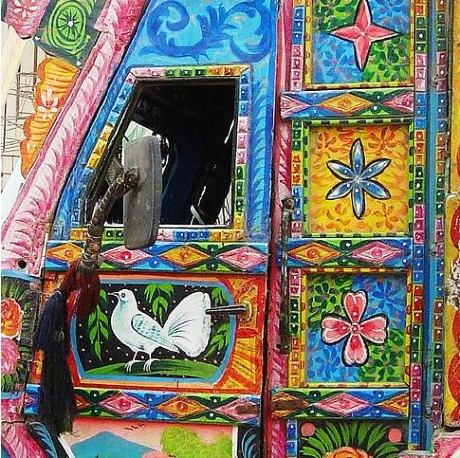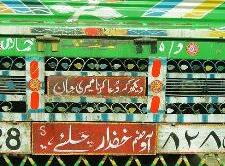Source: http://pakistaniat.com/2008/06/18/pakistans-indigenous-truck-art/

Just like the Billboard painting performed in Pakistan, there is another indigenous form of art performed in Pakistan and it is the Truck Painting. With its all colorful floral patterns, depiction of human heroes with creative aspect ratios, calligraphy of poetic verses and driver’s words of wisdom, this form of art is truly a part of Pakistani transport tradition.
I recently came across Abro’s photo collection of Pakistan’s truck painting and that provided me the necessary impetus behind this post. These photos were taken by Abro as part of a book called Food Path- Cuisine Along The Grand Trunk Road From Kabul To Kolkata
Source of these images: http://www.flickr.com/photos/abro/sets/72157594312151038/
This art is so Pakistani, that the freight trucks which are built by Ford, General Motors, Hino Pak etc in beautiful aerodynamic shapes are first retro-fitted with very Pakistani stlye bodies and a special ‘viewing deck’ at the top of Driver’s cab. The ‘viewing deck’ is a very multipurpose extra space. It is used by ‘cleaners’ to sleep at night and also to load extra luggage when needed.
Following Photo is the redesign of Ford Motor Company’s Logo by a Truck Painter in Pakistan

The Regional Flavor of Truck Painting
These truck bodies are then immaculately painted by the street artists who can be found at Truck stands all across the country. e.g. Hawkes Bay/Mauripur Road Road Karachi, Pir Wadhai Rawalpindi, Badami Bagh Lahore, Sariab Road Quetta etc. These hired artists then paint the whole truck in brightly colored patterns. It is said that everty city’s artists have perfected their art in their own signature way. Trucks decorated in Quetta and Peshawar get lots of wood trimming where as those in Rawalpindi get lots of plastic decoration. Karachi excels in using reflective tapes, also called ‘chamak patty’ in local language. Camel bone decoration is used by artists of rural Sindh.
In Karachi alone… more than 50,000 people toil in small, family-run workshops comprised of apprentices and highly trained artisans, each with his well-defined specialty. Dominated by the painstaking ethic of proudly independent craftsmen, this time-consuming manufacture is the opposite of mass production: Every hand-painted truck, bus and rickshaw, despite sharing numerous signs and symbols, virtually screams its uniqueness.
The Poetic Talent of Owner and Painter Shows on a Truck
Pakistani trucks are also used as means of displaying the owner or the Painter’s Poetic taste. It also serves as a calligraphic board as well as a notice board for public messages.
Note the two photos below. In the photo to the left the truck owner is declaring himself as hopelessly romantic (ye dil hai aashiqaana) and in the photo to the right he is requesting his beloved to accompany him to his hometown, which is by the way, Khuzdar Balochistan. (aao sanam Khuzdar chaleN)


History of Vehicle Painting in Pakistan:
Atleast one website (here) gives following history of bus/truck painting in Pakistan and quotes it to one Peter Grant.
The extraordinary tradition of decorating trucks has its roots in the days of the raj when craftsmen made glorious horse drawn carriages for the gentry. In the 1920s the Kohistan Bus Company asked the master craftsman Ustad Elahi Bakhsh to decorate their buses to attract passengers. Bukhsh employed a company of artists from the Punjab town of Chiniot, who’s ancestors had worked on many great palaces and temples dating back to the Mughal Empire.
It was not long before the truck owners followed suit with their own design. Through the years the materials used have developed from wood and paint to metal, tinsel, plastic and reflective tape. Within the last few years trucks and buses have been further embellished with full lighting systems.
A Small town in Northern Sindh called Ghotki is famous all over the world because of a truck painter who originally hailed from here. His name is ‘Kafeel Bhai’ and he signed his paint work on frieght trucks as ‘Kafeel Bhai Ghotki walay’ (brother Kafeel from Ghotki). As the number of trucks painted by him increased on the roads, so did his popularity because he not only signed his name on trucks but also wrote an introduction to himself as an ambidextrous cricket player who could do both slow and fast bowling. As cricket is a national passion in Pakistan, Kafeel bhai’s name spread far and wide. His signatures included the sentence:
‘cricket ka be-taj badshah’ (uncrowned king of Cricket) and ‘Left-arm right-arm medium-slow bowler, kafeel bhai Ghotki’
It is said that overtime his fame crossed seven seas and a team of reporters arrived from Australia to see his ambidextrous bowling. His introduction at Wikipedia says that nowadays he weaves cloth or nylon strings to make chairs in Ghotki. People who know him claim that he has reluctance accepting money from people and never demands money for his goods or services. People usually have to give it to him themselves. He often refuses to take the money in his hands and asks the buyer to just place it in his pocket.

No comments:
Post a Comment